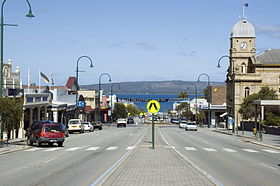Albany (Australia)
| Albany | |||||||
|---|---|---|---|---|---|---|---|
 York Street in the center of the city |
|||||||
|
|||||||
|
|||||||
|
|||||||
|
|||||||
|
|||||||
|
|
|||||||
Albany is a city in the Australian state of Western Australia (Western Australia) with 30,000 inhabitants. It is located in the Great Southern region , on the Great Australian Bay , 408 kilometers from Perth and about 53 kilometers from Denmark and has a large natural harbor .
history
In 1826 the first penal colony in Western Australia was established in Albany. The following year the British flag was hoisted and the city was named "Fredericks Town" in honor of Frederick, Duke of York and Albany . The city became a military outpost for New South Wales and the name Albany had become naturalized around 1830.
Between 1851 and 1880 Albany was an important port city as ships between the Eastern Colonies and Europe had to replenish supplies in Albany. With the development and use of more powerful ships, this stopover fell away and the place lost its economic importance. The opening of the railway line between Albany and Perth brought a renewed upswing from 1889, which however died out again with the expansion of Fremantle as a port city.
At the beginning of the 19th century, Albany became a major whaling center. The Cheyne Beach Whaling Station and the Norwegian Bay Whaling Station were set up in bays near Albany . Whaling quickly became the premier industry in Albany. Sales problems for products made from whales and from the 1970s onwards people became increasingly aware of the problem of whale hunting. Eventually whaling was banned in Australian waters and the whale industry closed the last whaling station in Australia in 1978.
"Whale-watching" (July to October) has now become a major attraction in Albany's small but growing tourism industry.
economy
Albany is a major business center in Southwest Australia. Economically, the city has focused on forestry, fishing, viticulture (Goundrey Wines), and tourism.
Attractions

Albany is located with its natural harbor on King George Sound . The place and the surrounding area offer a charming, varied landscape with granite rocks and sandy beaches. There are two hills in the village, Mount Melville (157 m) and Mount Clarence (186 m), which offers a good view of Albany.
At the port there is a museum complex that recalls the history of the place as a port city and whaling station. The Old Farm on Strawberry Hill was built in 1831, making it one of the first buildings. The St. John's Anglican Church was built in the 1840s, making it the first church in Western Australia . Also worth mentioning are the Mount Romance Emu Oil and the Sandalwood Factory .
Off the coast of Albany, the destroyer was in 2001 HMAS Perth the Royal Australian Navy sunk. This wreck and man-made reef is a popular destination among scuba divers.
nature
In the upstream Torndirrup National Park there are several natural coastal attractions such as the Natural Bridge and The Gap . There are numerous other national parks along the coast and in the hinterland, for example the Stirling Range National Park , which is about 90 km north of Albany. The special climatic situation makes it one of the most important botanical regions in the world. The Stirling Range is home to more than 1500 different plant species, 90 of which are endemic . The highest point in southwest Western Australia, Bluff Knoll , is also located there. Snowfall can be seen on its summit in winter, a phenomenon that is otherwise very rare in Western Australia.
Personalities
- Born in Albany
- Mark Atkins (* 1957), musician and artist
- Andrew McFarlane (born 1951), actor
Climate table
| Albany | ||||||||||||||||||||||||||||||||||||||||||||||||
|---|---|---|---|---|---|---|---|---|---|---|---|---|---|---|---|---|---|---|---|---|---|---|---|---|---|---|---|---|---|---|---|---|---|---|---|---|---|---|---|---|---|---|---|---|---|---|---|---|
| Climate diagram | ||||||||||||||||||||||||||||||||||||||||||||||||
| ||||||||||||||||||||||||||||||||||||||||||||||||
|
Average monthly temperatures and rainfall for Albany
Source: Bureau of Meteorology, Australia
|
|||||||||||||||||||||||||||||||||||||||||||||||||||||||||||||||||||||||||||||||||||||||||||||||||||||||||
Web links
Individual evidence
- ↑ Australian Bureau of Statistics : Albany (Urban Center / Locality) ( English ) In: 2016 Census QuickStats . June 27, 2017. Retrieved on 2020-04-076.
- ↑ Janine Günther, Jens Mohr: Western Australia and the Top End. Verlag 360 °, 2006, ISBN 3-9809763-1-9 , p. 188.

